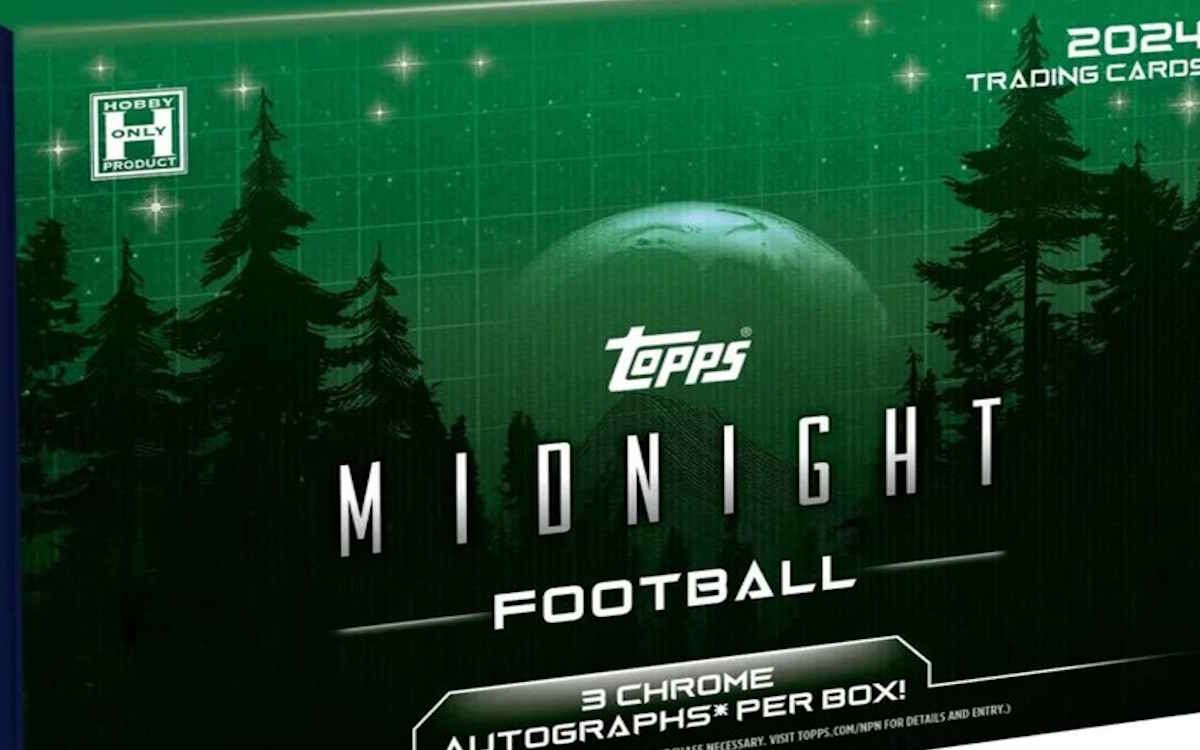

Ken Griffey Jr. was one of a kind in many ways. When one makes a short list of iconic rookie cards in the history of the hobby, his 1989 Upper Deck card appears prominently on the list, despite being released at the peak of the junk wax era.
But who was Griffey? And what is the best Ken Griffey Jr. rookie card? Which ones should you own plus what cards are worth a second look?
If you were going to invent a young player to become hyped in the hobby, it’d be Griffey. He was the son of Ken Griffey Sr., a successful major league who finished his career with over 2,000 hits, 150 home runs, and a .296 career batting average.
He was the 1st pick in the 1987 baseball draft. He rocketed through the minor leagues playing in only 130 games, in which he hit a scorching .318/.425/.572.
The difference is, where many hyped prospects end up as busts, Griffey is the happy path every team dreams of when making a #1 overall selection. Griffey debuted in the major leagues at age 19 and took the game by storm. He went on to play 22 seasons in the big leagues and was elected to the Hall of Fame with a near-consensus 99.3% of the vote.
Along the way, he was an All-Star 13 times, won 10 Gold Glove awards, 7 Silver Sluggers, and was the 1997 American League MVP. He led the league in Home Runs four times, and while he was slowed by injuries after turning 30, was considered one of, if not the best, player in baseball for most of his 20s.
He finished his career with 630 career home runs, which ranks 7th all-time. He finished with 2,781 career hits and 1,836 RBI. He hit .284/.370/.538 over his career, good for an OPS of .907 and an OPS+ of 136. He racked up 83.8 WAR, good for 5th all-time among center fielders.
All that was with the seasons after he turned 30 being somewhat of a disappointment. “They were great, but what could have been” has always been something that collectors find compelling (just look at Mickey Mantle).
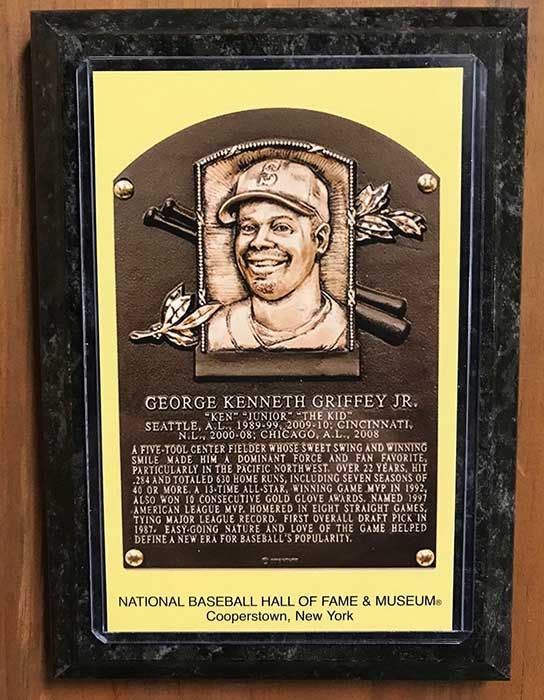
From the moment it was released, the 1989 Upper Deck Ken Griffey Jr. card became a hobby icon. Upper Deck changed the card game in 1989 with its inaugural release, and in making Griffey Jr. card #1 in their set they bet big on a hobby phenom.
The card captures Griffey’s trademark smile and still represents the potential of the great young player, and the brand new premium brand Upper Deck.
The total PSA pop for this card is a shocking 92,071 copies, accounting for over 50% of the total graded cards in the ’89 Upper Deck set. Of those cards graded by PSA, a total of 4,045 are PSA 10s.
Still, despite being far from rare, PSA 10 still sells strongly in the $1,700-1,900 range. Even PSA 9s, with a whopping population of 28,233, sell regularly for $175-200.

The 1989 Upper Deck card is the most popular and expensive of Griffey’s base rookie cards, but it’s far from the only Griffey rookie card worth considering and Ken Griffey Jr. rookie card value
1989 was the rebirth of Bowman after the brand’s disappearance decades earlier. With a simple design reminiscent of the 1953 Bowman Color set, it was poised to take the collecting world by storm.
Unfortunately, in the eyes of many collectors, these cards had a fatal flaw. They’re too tall! Measuring 2.5″ X 3.75″, these cards are a quarter inch taller than a standard card. That meant that they didn’t fit standard penny sleeves, top loaders, 9-pocket pages, and storage boxes.
The lack of popularity and probably the number of 1989 Bowman Griffey cards that got dinged up by not being properly stored makes this Griffey’s lowest overall PSA pop rookie card.
In a PSA slab, the extra size becomes less of a storage concern and allows the card to be enjoyed for what it is…a clean, classic Griffey rookie card.
Shop for 1989 Bowman Ken Griffey Jr. cards on eBay
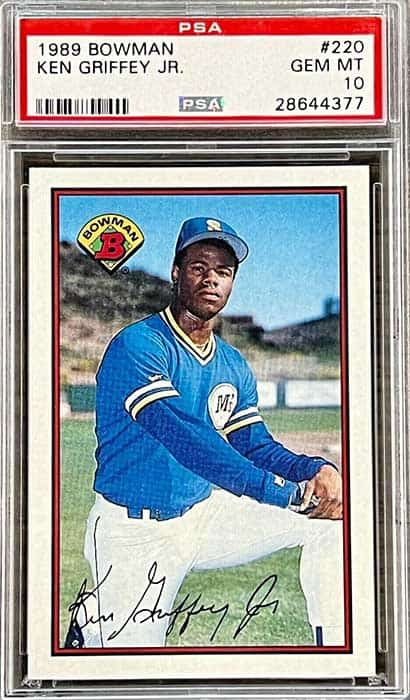
The 1989 Donruss set is one of the “junkwaxiest” of the junk wax era. That being said, these orange stock cards were printed on thin stock, and finding them in top condition is a challenge. While over 40,000 copies of the Ken Griffey Jr. rated rookie card have been graded by PSA, fewer than 2,000 have been graded PSA 10.
Because of this, a PSA 10 will set you back more than Griffey’s other non-UD rookie cards.
Shop for 1989 Donruss Ken Griffey Jr. rookie cards on eBay
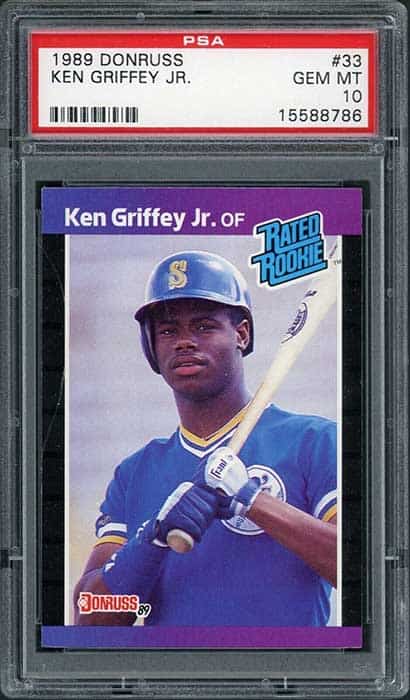
The high population count on this one keeps the price reasonable, even for a PSA 10. With over 5,000 PSA 10s out there, it’s not rare, but that helps keep it affordable. If you’re looking for a Griffey rookie card but don’t want to break the bank, this is a solid option.
Shop for 1989 Fleer Ken Griffey Jr. rookie cards on eBay
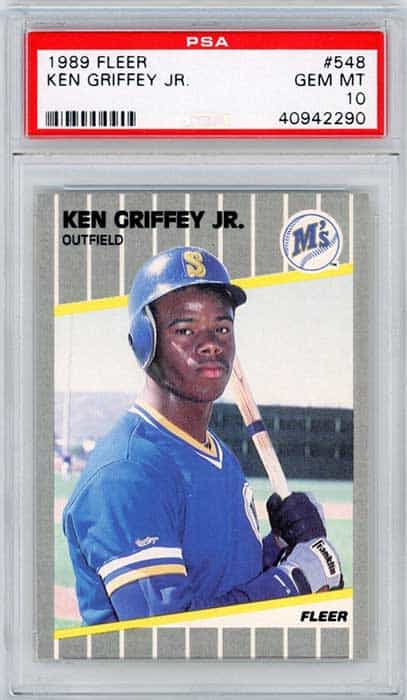
Somehow, Score and Topps missed out on Griffey in their flagship offerings and included him in their Traded set. Being not a true rookie card (it’s an XRC), its value is a tick below most of the other Griffey rookie cards, making it another option for price-conscious fans.
The fact that 1989 Score sports an underrated set and nicer-than-average card stock for its era doesn’t hurt any.
Shop for 1989 Score Ken Griffey Jr. rookie cards on eBay
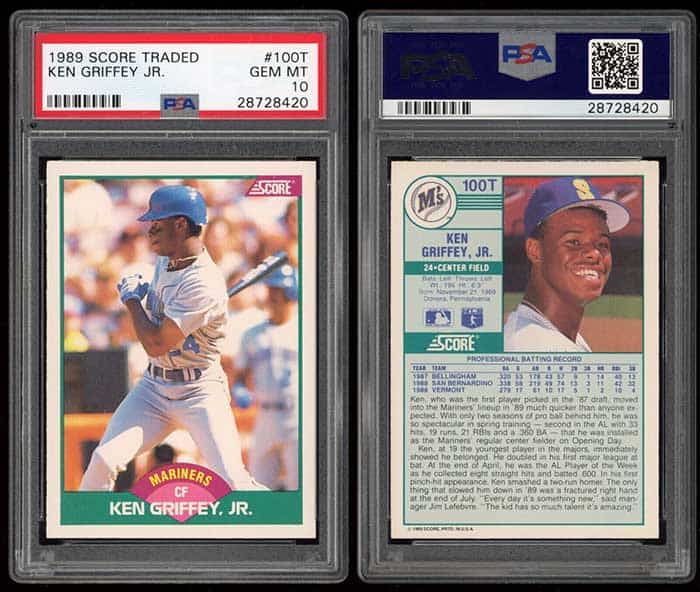
Another XRC, this card has been graded by PSA a shocking 80,000 times, with over 13,000 PSA 10s. That high population combined with it being an XRC keeps the value on the lower side.
Personally, I think this is a great-looking card, and aesthetics and eye appeal certainly have a place when picking which cards to pursue.
Shop for 1989 Topps Traded Ken Griffey Jr. rookie cards on eBay

Ken Griffey Jr. rookie card value is probably a high point at the moment, but the cards still represent some of the most valuable rookie base cards from the era. How much is a Ken Griffey Jr. rookie card worth? Let’s take a look at the value of his main rookie cards below:
| Card | Total PSA Pop | PSA Comp Pop | Recent Comp Price |
|---|---|---|---|
| 1989 Upper Deck Ken Griffey Jr. #1 | 92,071 | PSA 10 = 4,045 | PSA 10 = $1,700-1,900 |
| 1989 Bowman Ken Griffey Jr. #220 | 26,002 | PSA 10 = 2,261 | PSA 10 = $200-250 |
| 1989 Donruss Ken Griffey Jr. #33 | 40,785 | PSA 10 = 1,915 | PSA 10 = $300-$350 |
| 1989 Fleer Ken Griffey Jr. #548 | 57,991 | PSA 10 = 5,093 | PSA 10 = $140-150 |
| 1989 Score Traded Ken Griffey Jr. #100T | 28,096 | PSA 10 = 4,731 | PSA 10 = $80-100 |
| 1989 Topps Traded Ken Griffey Jr. #41T | 80,001 | PSA 10 = 13,158 | PSA 10 = $100-130 |
1989 was right in the heart of the junk wax era. High print runs mean that finding anything even close to “rare” is a challenge. An option exists, though, in the form of Fleer Glossy and Bowman and Topps Tiffany.
The estimated print run for 1989 Bowman Tiffany was 6,000 sets. That doesn’t sound rare by modern standards, but for the era, that’s downright scarce.
With a low overall PSA pop and barely 150 PSA 10s, this one doesn’t come available often, but when it does, it’s easily the highest-priced Griffey year card in top condition.
Shop for 1989 Bowman Tiffany Ken Griffey Jr. rookie cards on eBay
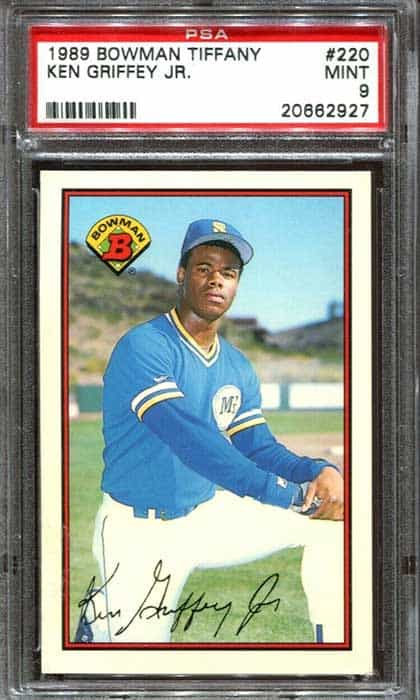
While not nearly as limited as Tiffany sets, Fleer Glossy is much harder to come by than the standard Fleer set. The estimated print run was 30,000 sets.
Of all the rookie cards discussed in this article, this one has the fewest PSA 10 copies in existence, with 118 as of this writing. It’s a strong seller when it comes available, which isn’t often.
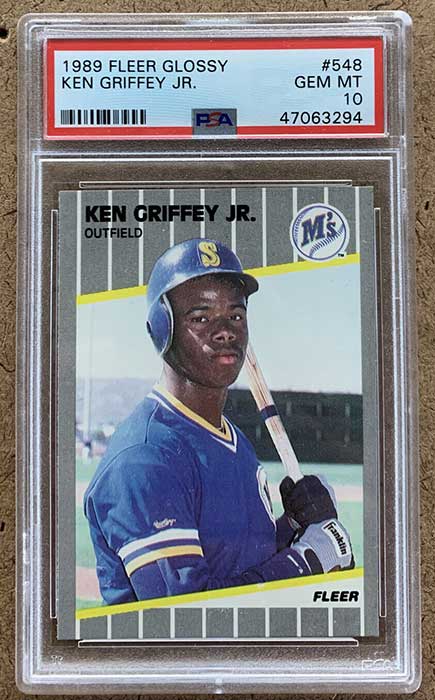
If you think a print run of 30,000 is too many, but 6,000 is too few, here’s your Goldilocks print run. The 1989 Topps Traded Tiffany set had a print run of a “just right” 15,000 sets.
Despite more copies graded by PSA and more 10s than the other two sets, it’s still a strong seller and a popular card among Griffey fans.
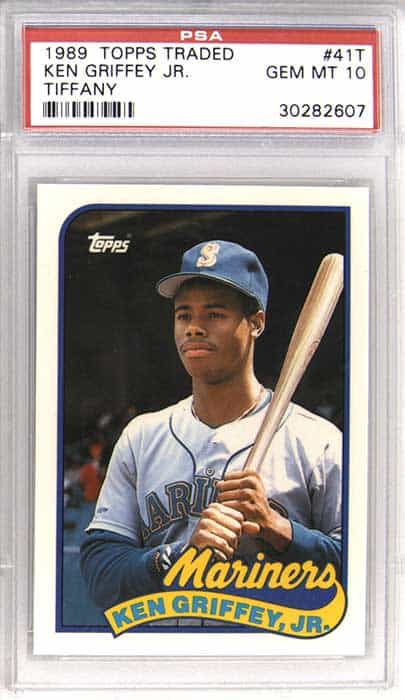
| Card | Total PSA Pop | PSA Comp Pop | Recent Comp Price |
|---|---|---|---|
| 1989 Bowman Tiffany Ken Griffey Jr. #220 | 1,643 | PSA 10 = 156 | PSA 10 = $13,000 |
| 1989 Fleer Glossy Ken Griffey Jr. #548 | 1,927 | PSA 10 = 118 | PSA 10 = $3,500 |
| 1989 Topps Traded Tiffany Ken Griffey Jr. #41T | 2,158 | PSA 10 = 333 | PSA 10 = $4,000 |
Beyond the standard rookie cards, Griffey did appear on a number of other cards during his rookie season of 1989. While not considered rookie cards, they are still popular cards to this day.
Bowman capitalized on the popularity of Griffey and the fact that he was a second-generation major league whose father was still an active player with this card.
It’s a pretty cool concept and a great way to celebrate just how rare it is to have two generations of a big-league family playing at the same time.
With a lower PSA pop than the regular rookie cards and a very reasonable price, even in PSA 10, this is a great option for the price-conscious collection.
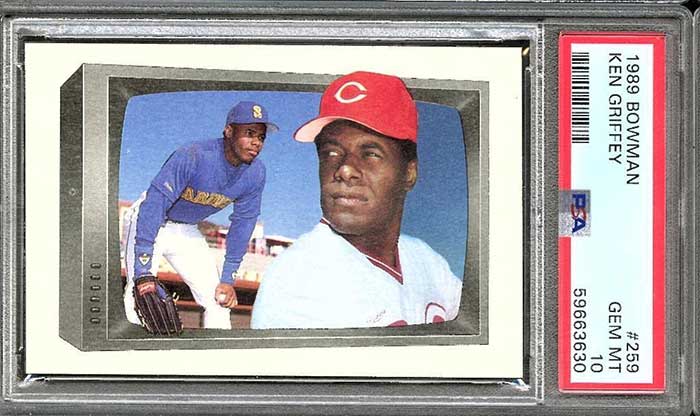
Classic released baseball cards along with a board game baseball game in the late 1980s and early 1990s. Griffey appeared in the “Travel Update” offerings from Classic in 1989. Card #131 appears in the “Travel Update I” set.
Almost 27% of the 3,500 copies of this card graded by PSA were graded PSA 10. It sells for a very reasonable price, even in PSA 10, and is a nice option if you’re looking for an alternate 1989 Griffey that won’t break the bank.
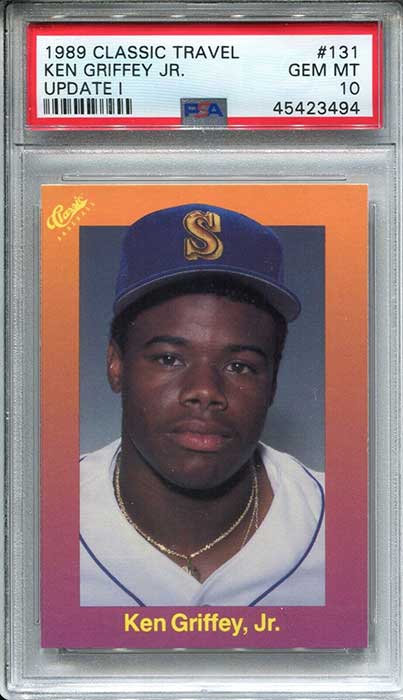
Classic card #193 was part of the “Travel Update II” set. In fact, this card was on top of one of the two stacks of cards in the plastic clamshell package the set came in. That top spot made it easy to see, but caused many of the cards to be damaged, leading to a lower PSA pop and higher prices than card #131.
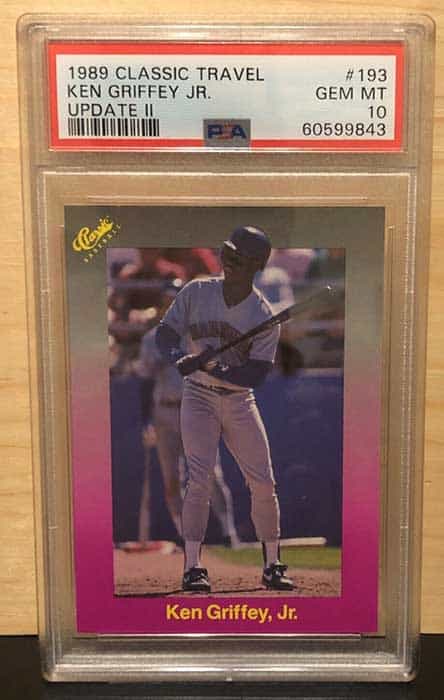
Another small box set, 1989 Donruss Baseball’s Best was a bit tougher to find than most cards in 1989. It continues to provide strong value despite healthy PSA pops.

As we explored earlier, some of the big card producers got Griffey into their flagship product, while others got them into their rookie/traded offering. Donruss put Griffey in both.
With by far the highest pop on this list, it sells for a solid $150-200 in PSA 10, but far less in PSA 9 and below.
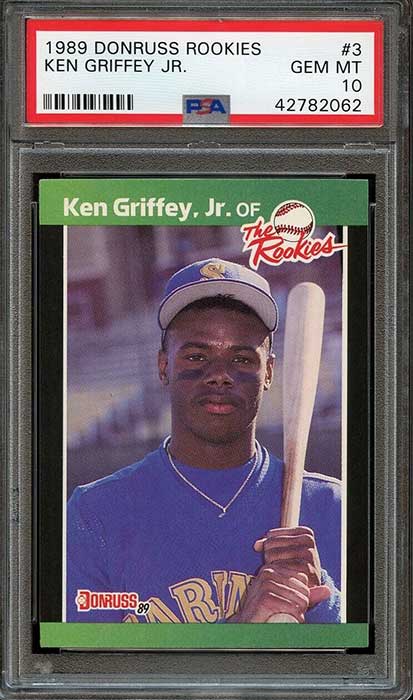
| Card | Total PSA Pop | PSA Comp Pop | Recent Comp Price |
|---|---|---|---|
| 1989 Bowman Ken Griffey Jr. / Ken Griffey Sr. #259 | 3,518 | PSA 10 = 593 | PSA 10 = $60-90 |
| 1989 Classic Ken Griffey Jr. Travel Update I #131 | 3,511 | PSA 10 = 939 | PSA 10 = $75-125 |
| 1989 Classic Ken Griffey Jr. Travel Update II #193 | 1,788 | PSA 10 = 264 | PSA 10 = $200-300 |
| 1989 Donruss Baseball's Best Ken Griffey Jr. #192 | 3,868 | PSA 10 = 477 | PSA 10 = $250-450 |
| 1989 Donruss The Rookies Ken Griffey Jr. #3 | 14,079 | PSA 10 = 1,739 | PSA 10 = $150-200 |
Ken Griffey Jr.’s popularity in 1989 knew no bounds. According to the Trading Card Database, he appeared on 166 different cards that year.
Dozens of these cards were unlicensed, created as people tried to produce on Griffey’s popularity and the trading card boom. While most of these cards don’t have a lot of value these days, they’re interesting reminders of the days when Griffey ruled the world and are interesting additions to any Griffey collection.
The now-defunct Mother’s Cookies company produced a Griffey Jr. set. The cookie company was known for producing mostly regionally distributed team sets as giveaways with their products.
Prefer chocolate bars to cookies? Griffey was such a big deal that he had his own candy bar in 1989, putting him in the same stratosphere as “Baby” Ruth and Reggie Jackson (“Reggie”).
The former British island colony of St. Vincent even got in on the action creating Ken Griffey Jr. postage stamps.
There’s even a rare Topps “Head’s Up” Test release out there if you can track one down. The sheer volume of oddball Griffey items released in 1989 is a testament to both his popularity and the junk wax era hobby “gold rush”.
So, what you’ve probably noticed so far are some really high PSA populations. It was the junk wax era, and they didn’t come more popular than Griffey. But you’ll also notice some really solid sale prices, especially in PSA 10. The demand remains for Griffey.
But which card or cards should you buy? If you don’t own the 1989 Upper Deck card, you may want one. I don’t know that it has a lot of upward movement left in it, but it’s probably THE iconic card of its era and has a place in just about any collection.
Beyond that? The 1989 Bowman is lower pop than many of his rookie cards. If collectors move past the dislike for the larger card (perhaps easier to deal with when graded?), it could be a solid investment.
I personally think the 1989 Topps Traded Griffey is his best-looking card from 1989. If you agree with that assessment, it’s an affordable buy with that huge pop.
If your budget allows, the really interesting cards are the Glossy and Tiffany cards. They’re low population and sell for big bucks, but these are going to be THE premium Griffey cards for the big-money collectors going forward.
Are you the kind of collector who spends big on high-end, premium, ultra-modern products that include only a handful of cards in them in hope of the big hit? The junk wax equivalent might just be buying a 1989 Fleer Glossy or 1989 Bowman or Topps Traded Tiffany set and hoping to pull a Gem Mint Griffey.
Centering issues, potential bricking, and 33 years of storage make that no sure thing…but the potential payoff could be substantial. And it’d be a lot of fun to take the walk down memory lane that sorting through the set would provide.
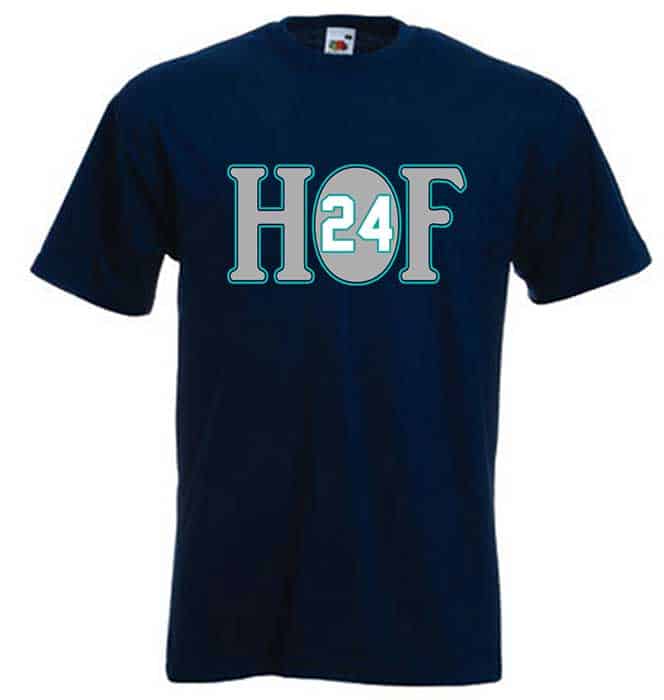
Thirty-three years after their release, there may not be a lot of upside in Ken Griffey Jr.’s 1989 cards. That being said, they hold solid value and remain popular with collectors despite high population counts. Think of them as the blue-chip stock of the junk wax era.
On top of the value, these cards tell the story of a highly touted player who made it big during the peak of the last baseball card bubble.
More Cardlines Top Rookie Card Coverage

Is buysportscards.com a good place to Buy Sports Cards?
We Tried GameStop's PSA Card Grading and Got Surprising Results!
Can you crack a TAG graded slab barehanded?
Comparing Tag Grading to PSA: Slabs, Prices and More!
BIG news from CGC grading!
5 HUGE redemption in 6 boxes of 2025 Heritage?
A new VeeFriends release with 1% the print run of the first! (Must buy!?)
I made a FREE ad for Arena Club Slab Packs (without them asking for it)

© Copyright 2025 - All rights reserved Cardlines.com / Media Techs LLC - Sports Card News, Reviews, Releases and BREAKS - #thehobby.
Important: When you click on links to various merchants on this site and make a purchase, this can result in this site earning a commission. Affiliate programs and affiliations include, but are not limited to, the eBay Partner Network.
Gamstop is HACKING the cards and collectibles industry
Cardlines 4 hours ago